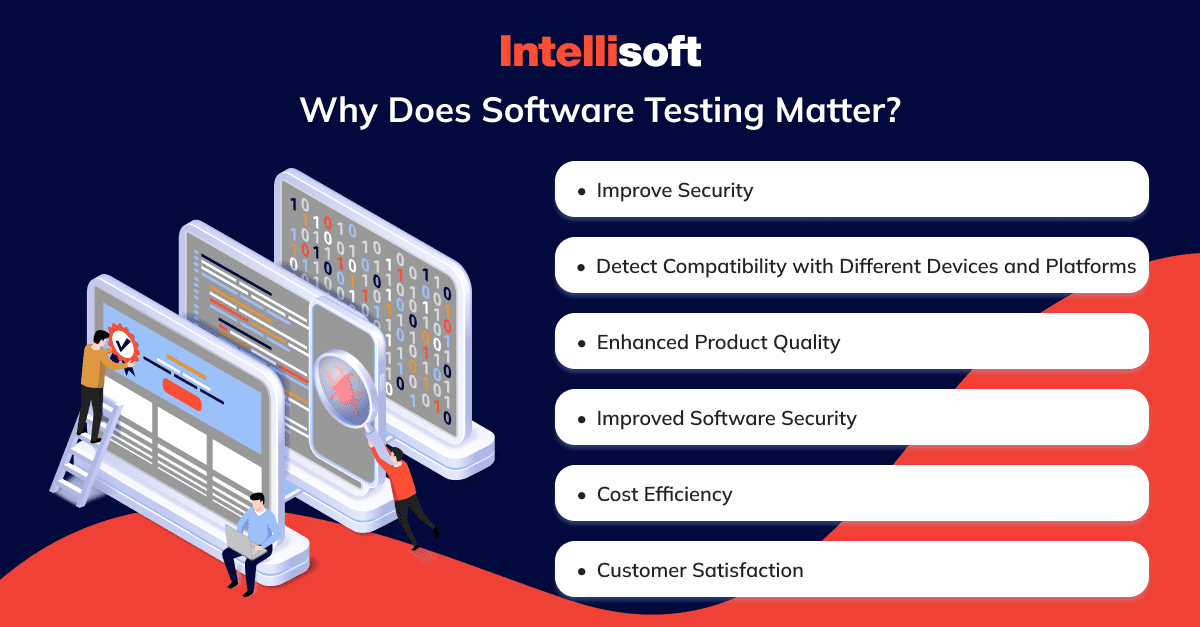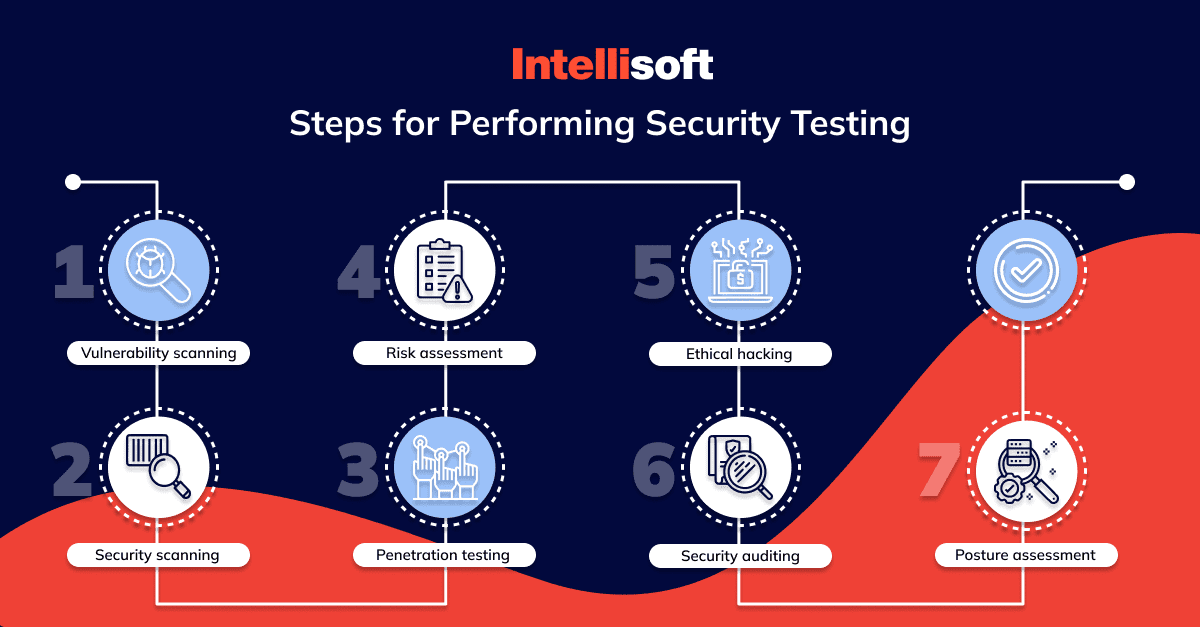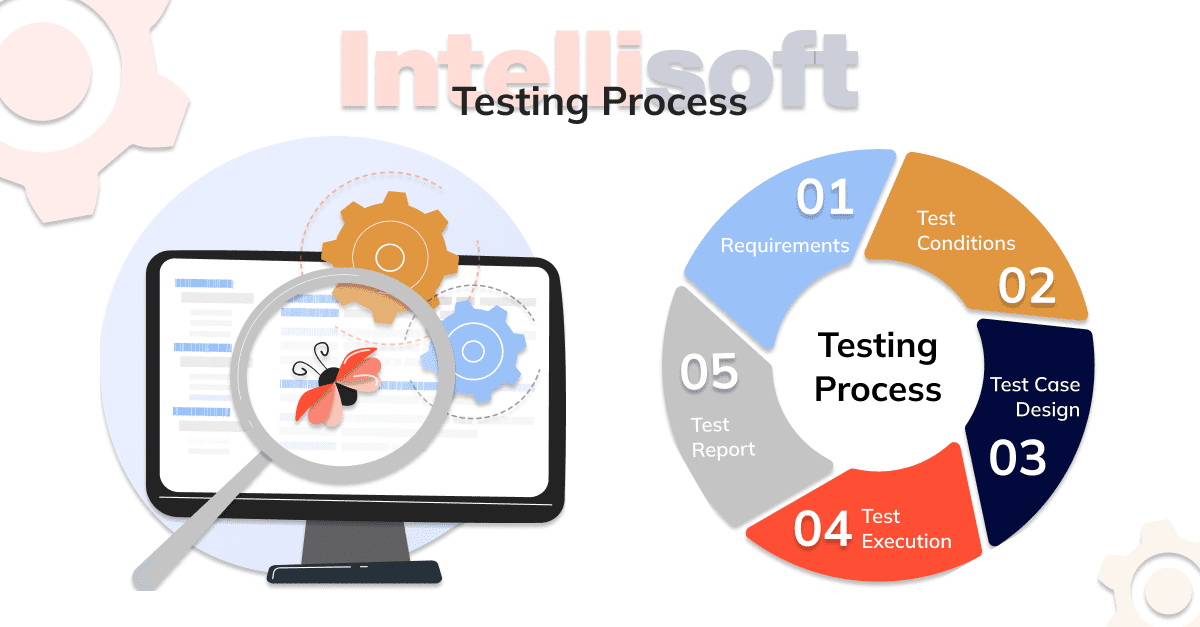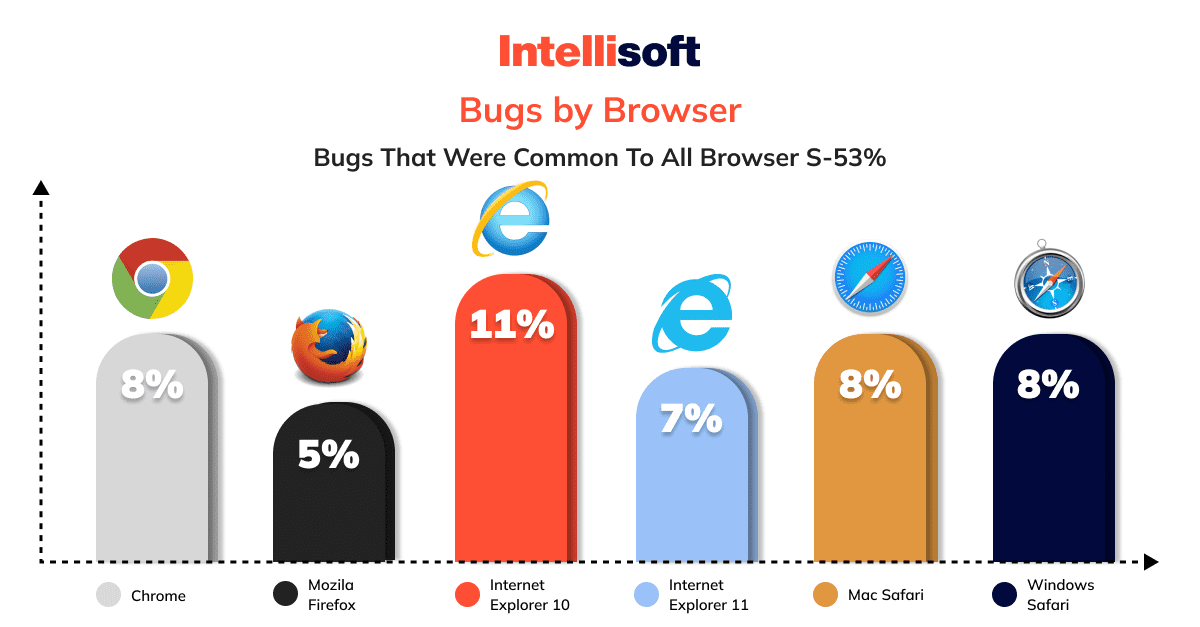Software testing definition is an expansive and crucial aspect of software development that plays a vital role in ensuring the quality and reliability of software products. Through meticulous testing, software testers can identify and rectify bugs and errors, ultimately leading to improved performance, cost savings, and enhanced security for software products. The fundamental processes of software testing encompass defining the test environment, analyzing test results, creating test cases, scripting, and reporting defects. All these procedures make testing an integral part of the software development life cycle (SDLC).

Some facts and stats prove the vital role of app examination. For instance, the software testing services market is about to hit an estimated CAGR growth of 7% because of the higher integration of AI between 2021 and 2027. For the United States, the application testing services annual market size growth has been hovering around 8% in 2017-2022. You should not worry if you have no internal testers. After all, roughly 35% of companies recruit or use non-testers for software testing purposes. Do not worry – this post will shed light on this topic. Learn more about various types of software testing and its significance in development.
Table of Contents
What is Software Testing? Definition & Meaning
What is software testing? Software testing is the examination and observation of a piece of software to check the correspondence between the real behavior of the app and its expected behavior on a finite set of tests chosen in a certain way.
The purpose of software testing covers is:
- To ensure that the software gets rid of bugs to an acceptable level (you can’t provide 100% coverage, but you should do your best, and ensure that bugs on the surface are corrected).
- To ensure the application corresponds to the initial expectations. Does the product meet all quality standards and the original requirements?
Current software testing methods do not allow to detect all defects and Guarantee 100% accuracy of functioning. They do not necessarily establish the correct functioning of the analyzed program, so all existing testing methods operate within a formal process of verification of the product being researched or developed.
Such a formal verification process can prove that there are no defects in terms of the method used. That is, there is no way to accurately establish or guarantee the absence of defects in a software product, provided the human factor. After all, human specialists are involved in every phase of the product development and further release.
Anyway, effective testing of software products is a rather creative process that is not limited to following or creating strict and clear procedures.
Software quality can be defined as an aggregate feature of the observed product taking into account the following components:
- Reliability
- Maintainability
- Usability
- Efficiency
- Mobility
- Functionality
What Is the Importance of Software Testing?
So, we’ve just learned what is software testing. It is a very important activity associated with development, and without it, it would be impossible to launch any website, mobile application, game, etc. Here are just the most striking examples of errors that testers can spot:
- On website A, the user has to type in the answer to the question posed. After entering the data, they press the Enter button to proceed, but instead of going to the right page, they are thrown back to the homepage, and the written answer is not saved.
- Another example is buying a product in an online store. The client who makes a purchase sends the item to the cart. When they click the Pay button, they are redirected to the main page instead of the Online Checkout page.
- A PC user has installed a wandering game. In a couple of minutes, they notice that the player begins to behave inadequately, does not respond to commands, performing the opposite actions instead. As a result, the task turns out to be a failure, and the screen is decorated with the annoying Game Over.

Testing is important because software errors can cost the manufacturer a lot. They can lead to severe financial losses and even disasters. History is full of such examples.
- In 1985, Canada’s Therac-25 radiation therapy machine malfunctioned due to a software error and delivered lethal doses of radiation to patients, killing three people and severely injuring three others.
- On April 26, 1994, a China Airlines Airbus A300 crashed due to a software error, killing 264 innocent people!
- In May 1996, a software error caused $920 million to be deposited in the bank accounts of 823 customers of a major US bank.
- In April 1999, a software error prevented a $1.2 billion military satellite from launching, making it the most expensive accident in history.
- A vulnerability in Windows 10 allowed an isolated software security environment to escape through a breach in the win32k system.
- In 2015, an F-35 fighter jet fell victim to a software glitch that prevented it from detecting targets correctly.
- Nissan has recalled more than a million vehicles from the market due to an airbag sensor software failure. Two accidents have been reported due to this software failure.
- Starbucks was forced to close about 60% of its stores in the US and Canada because of a software failure in its point-of-sale (POS) system. At one point, the store served coffee for free because they were unable to process the transaction.
- In April 2015, the Bloomberg terminal in London malfunctioned due to a software failure affecting more than 300,000 traders in the financial markets. This forced the government to postpone the sale of the £3 billion debt.
The importance of software testing process is obvious just based on these examples alone. Still, you may have no idea how to handle this process or where to get pro help with it, we know what to do. We at IntelliSoft offer quality and rapid quality assurance software testing services. Our company has been creating market-leading standards for code-printed goods and services. You can learn more about what exactly we can do for you at any time.
The Benefits of Software Testing
Experts highlight the following benefits of using manual software testing and auto-testing.
Product quality
What is the main goal of a product or service? The good should solve the user’s problems. In other words, the idea is to bring value to its customers. Software testing process ensures that the product meets business requirements and fulfills its functionality.
Customer satisfaction
Unless the user is an ardent fan of a particular brand, when choosing from several similar products, the user chooses the one that is more convenient. UI/UX testing provides a better user experience.
Profitability
If bugs are detected at an early stage of software development testing, it is cheaper to fix them. Timely testing of any IT project will help you save money in the long run. It is definitely one of the key testing advantages.
Security
People are looking for proven products. Testing software development gets rid of the risks of information leakage.
Related readings:
- Monolitic vs Microservices Architecture: Pros and Cons
- What Is a Secure Software Development Life Cycle?
- Legal Requirements for Storing Data: Key Insights for Storing User Data
- DevSecOps: Defined, Explained, and Observed in One Article
H2 Different Types of Software Testing Techniques
It is important to not only know what is software testing, but also note that there are various techniques used within software testing to ensure comprehensive coverage. Some popular techniques include:
- Black-box Testing: This technique focuses on testing the software without having knowledge of its internal workings.
- White-box Testing: It examines the internal structure and code of the software to identify potential issues.
- Regression Testing: This technique retests previously validated functionalities to ensure that modifications or additions have not introduced any new problems.
- Exploratory Testing: It involves simultaneous learning, design, and execution of tests to uncover unforeseen defects.
Choosing the right technique depends on the nature of the software and the specific objectives of the testing phase.
Levels of Software Testing
Many different types of app tests and product testing software exist. They all have their unique approaches and targets, so decide which ones suit you best.

- Acceptance testing. Acceptance testing is usually a set of manual tests conducted after the end of the development process. It examines whether the written functionality meets the initial specifications or the acceptance criteria.
Say, the examinations show adverse outcomes. Then, it looks like you missed some functionality when you wrote your code. You’ll have to go back to the development phase and fix it. If the acceptance tests fail, you should probably decide on the acceptance criteria early in the software testing planning process.
You and your project owner should outline the acceptance criteria before you start work on the project. Any additional work discovered or added to the project should also be reflected in the acceptance criteria. Acceptance tests should take place shortly after development is over so that you can conduct the major changes you need to make early on before continuing with the testing process.
- Integration testing. Integration tests test the interaction between two or more separate units of your code. Your application consists of individual units that perform certain small features. Each of them may work well in isolation, but break down in conjunction with the others.
Integration tests also examine the integration of your code with external dependencies, like database connections or third-party APIs. Integration tests are the next step after unit tests.
Integration test failure means that two or more features of your application don’t work together. It could be two modules you’ve written that conflict because of some complex business logic. It could also be a failure because a third-party API response structure has changed. A test failure can be a warning of poor error handling in the event of a database connection failure.
Causes of failures can be easily determined, but manual checks or certain experiments may be needed. If dealing with integration test failure is difficult, it can be an indication that logging and error handling can be improved.
- Unit testing. Unit tests check whether each individual module (unit) of your code works properly. Ideally, when planning and writing unit tests, you should isolate functionality that cannot be separated into smaller components and observe it.
Unit tests should not test external dependencies or interactions. You definitely need to mock out API calls. Purity fighters for unit tests will also insist on mock database calls to make sure that your code, obtaining the correct input from external sources, acts correctly.
Whether you can do this depends on the kind of codebase you have and your manager’s preferences. If you can’t eliminate database functionality from your set of unit tests, keep performance in mind and look for potential optimization opportunities. In my experience, long running unit tests are extremely frustrating and slow down development significantly.
You must write and run unit tests in parallel with your code. When people refer to development through testing (TDD), we are talking about unit tests. These tests are used as a specification of what the code should do.
Failure of a unit test means problems in a certain part of the code. If you’ve broken your code into modules (down to the smallest ones) well enough, test failure will come down to a specific piece of code that doesn’t work as it should. Test failures should help you find and fix problems quickly. They also let you know when your specs need to be updated. It may also be a good indicator that you have to update your code documentation. Therefore, companies need to hire unit testing experts to complete this task.
- Security testing. It is a type of software testing that identifies system vulnerabilities and determines whether system data and resources are protected from possible threats. This ensures the software system and app are free from any risks that could lead to losses. Security testing of any system aims to find all possible loopholes and weaknesses in the system that could lead to data leakage or the organization’s reputation. Six basic principles of security testing involve privacy, integrity, authentication, authorization, accessibility, and integrity.

- Performance testing. Performance tests assess the stability, scalability, and usability of your product and infrastructure. You can measure things like the number of errors per second or how long it takes to load a page. Performance testing doesn’t necessarily have any pass or fail criteria. This stage is more about collecting data and finding ways to improve.
Failing performance tests is different from failing, say, unit tests. In them, you collect a set of marks and check those numbers against the desired ones. Failure of performance tests shows you need to pay more attention to scaling infrastructure, database query times, and other things. Performance testing would be a good idea after the main release and refactoring.
- Functional testing. Various types of functional testing can be carried out at various levels of examination. Those are unit testing, computer systems testing, and integration testing. These exams have to ensure the product’s compliance with the prescribed functionality and behavior. The functional part of the application involves the external behavior, meaning the wishes of end users. The customer should be happy at an early design and development stage.
- Regression testing. Regression tests evaluate a set of scenarios that used to work and should be relatively stable. Regression tests should be run after successful integration tests. Do not add new features to the regression test suite until you have regression tested the functionality already in the suite.
If regression tests fail, it means that the new feature broke some existing feature, leading to regression. Failed tests let you know something in the old features is broken. This tells you to write additional integration tests for the new and old (broken) functionality.
Also, failure of regression tests can indicate that you accidentally reintroduced a bug already fixed in the past.
- Smoke testing. Smoke tests are a high-level, carefully selected set of automated tests, ranking somewhere between integration and regression testing. It’s a check to make sure that the core functionality of your website is working properly.
The term “smoke test” has its origins in work that has nothing to do with programming. For example, by running smoke through a chimney, you could detect and repair defects in the chimney.
Smoke tests should test your system as a whole to ensure that all major functionality is working properly. They do not have to be comprehensive. You should run such tests early and often, ideally daily, in both staging and production.
Failed smoke tests mean a noticeable issue in the functionality of your website. You should not roll out new changes until the problems are fixed. If a similar failure occurs in production, fixing the problem should be a high priority.
What Is Smoke Testing in Software Engineering?
So, what is smoke testing in software engineering? Smoke testing refers to the initial, basic tests conducted to verify that the critical features of the software are functioning correctly and are stable enough for additional testing. It acts as a preliminary check before diving into detailed testing.
During smoke testing, the software is briefly run to identify any significant issues or failures that could prevent further testing. It helps ensure that the fundamental functionalities are intact before investing resources into thorough testing.
Software Testing Process
Here are the software testing steps one should take to conduct an accurate process.

Test Analysis
The first phase, which is the analysis phase, is the main stage of the software testing process. This step includes the analysis of functional and non-functional requirements such as business requirements, functional documentation, technical specification documents, etc.
At this stage, it is necessary to prepare a document where employees would prescribe the necessary amount of work to identify key bugs. The test plan specifies when testing can be completed. This document is not static – on the contrary, adjustments will be repeatedly made as part of the work, which allows you to choose the best strategy for analysis.
To sum up, in this phase, testers check requirements and functional specifications to make sure they are clear, consistent, complete, executable, and testable.
Test Planning, Strategy, & Preparation
Once testers have understood the requirements, they can move on to developing a testing strategy and planning quality control procedures. At this stage, they determine the scope of work and budget, decide what approach to use at each stage of software development, detect types of testing that will be required, and choose tools that are best to use.
At the same time, test teams start getting ready with test suites and test data. What is test case in software testing? A test case in software testing is a document that describes the steps required to test any functionality with expected and actual results. One more thing needed is a RTM. A requirements traceability matrix (RTM) is a document that maps conditions necessary to test cases and ensure testing process is 100% complete.
All valid and invalid test data sets must be crafted carefully for every test case. At this stage, a test data document must be prepared as well. Test data are also generated based on some algorithms and software testing tools. After the code part is completed, the code is tested with the configuration management tool. Then, a test build is prepared where testers should start running the test.
Test Execution
Do not forget to do one more thing before actual application development testing. With a plan in hand, it’s time to develop test scenarios/test cases, come up with checklists, prepare the environment for running tests, and create scripts for automated testing.
So, at this app testing stage, everything is ready to search for bugs and defects. A team of QA specialists begins to perform various types of examinations. The testers report all detected bugs. Wherever the actual and expected results do not match, the tester reveals bugs and assigns them to the developers.
Once the development team fixes the problem(s), testers recheck the functionality and do what’s known as regression testing to make sure that the software still works correctly after the corresponding changes.
Test Closure
After all planned tests have been executed and all corrections have been made, it is time to report on the test outcomes. The documentation describes testing in software development. There are various software automation testing tools and methods for root cause analysis, for which there have been many studies done in the past.

Best Practices Software Testing to Try
The integral elements of excellent testing methodology are user interface (UI), app programming interface (API), and system levels. It is also recommended to run multiple tests as early as possible. Internal instruments for automation would help as well. Still, only vendor solutions can streamline the following processes:
Bug/error tracking. Both developers and testing specialists should be involved in this process. Otherwise, it won’t be possible to improve the software’s quality. With the help of automated instruments, experts can evaluate a project’s scope, track bugs, and uncover related problems.
Ongoing testing. It is necessary to integrate test automation tools with the deployment process to examine every build once it is carried out. This stage assists with minimizing threats and improving design.
Service virtualization. This process stimulates the missing systems, making it possible to decrease dependencies. They can re-use and modify a configuration to try and examine various scenarios.
Configuration management. Experts need access to coding, design documentation, scripts, models, and outcomes of observation. The idea is to minimize administrative effort.
Metrics & reporting. This step is necessary for sharing status, objectives, and testing outcomes. Thanks to metrics that show up in a dashboard, experts can view the general project’s health and control relationships between examination, development, and other things.
Importance of Software Testing: To Sum Up
Regardless of what methods the company uses, the ultimate goal is always the same – to provide customers with the highest quality product. In this article, we define software testing as an activity designed to verify that actual results correspond to expectations and the product is free of defects. With program testing, you can test every aspect of your product. For example, you can use software testing to check whether the application is compatible with your browser.
In case you manage to find any bugs, you will have the opportunity to fix them. In this way, you can prevent yourself from complaints and slowly but gradually gain high visibility. A well-established QA process helps reduce development costs and improve software quality. In addition, a professional outsourced team of experts can accomplish all steps necessary to create an app that everyone would love.
If software testing seems too complicated for you, mind that you can always turn for help to our team. IntelliSoft is a software testing company that provides IT talents for software check and other activities engaged in the software development process. We have an impressive portfolio of success cases. After viewing them, you may discover that our company is what you need. Send us a quote or move right to the discussion of your projects with our experts!









